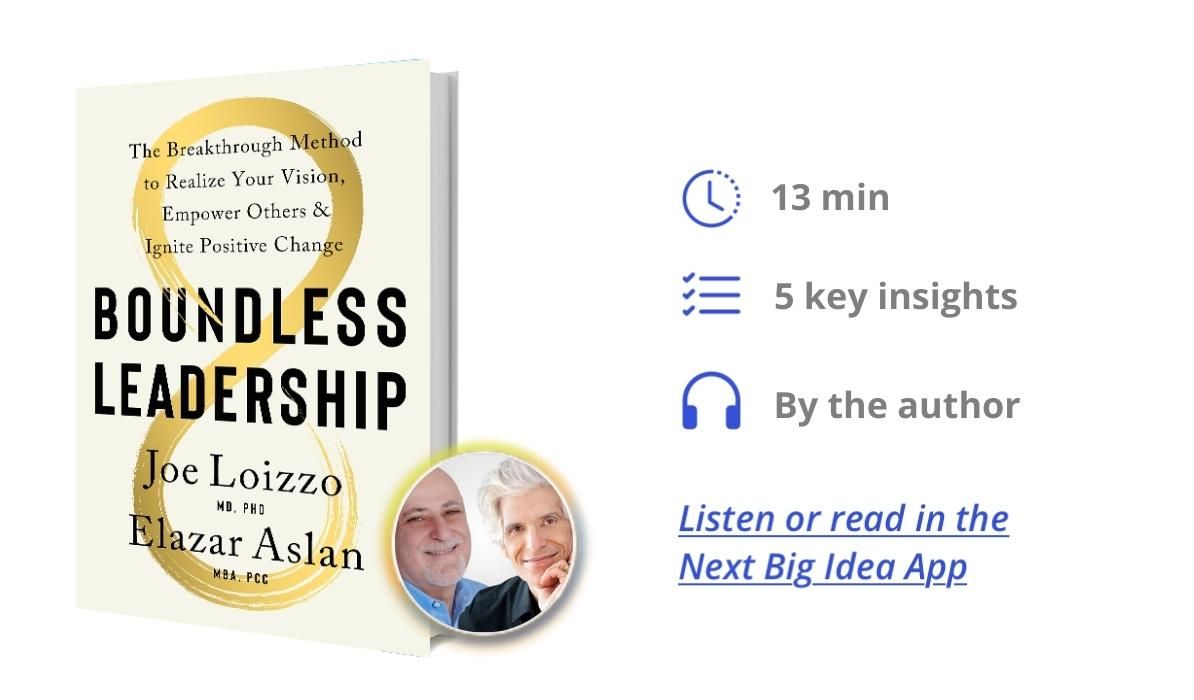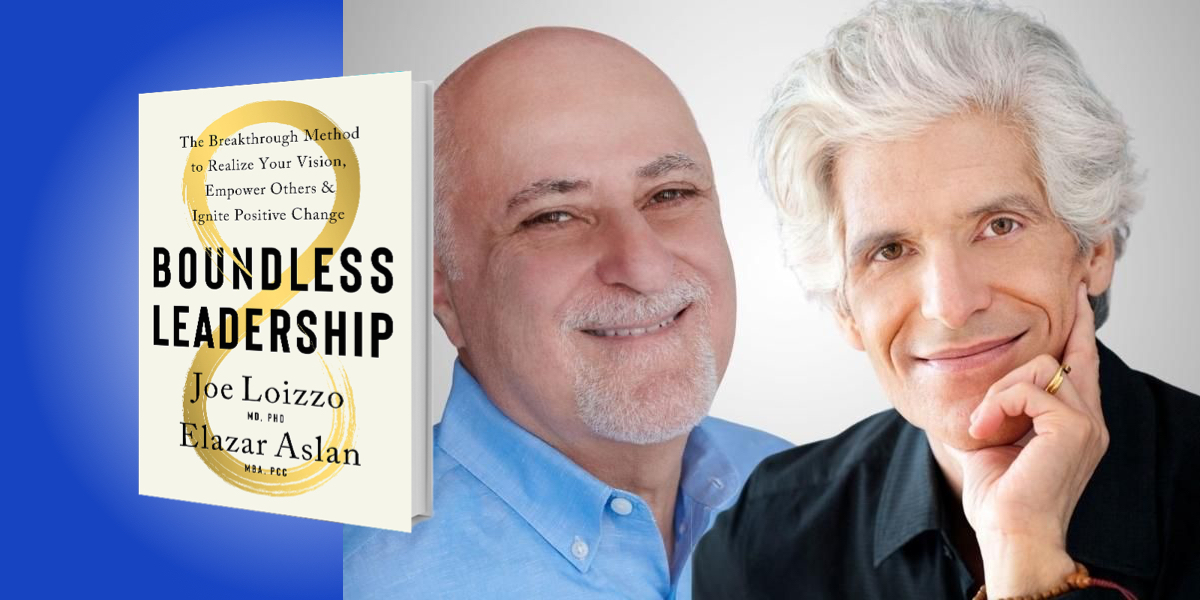Joe Loizzo, MD, PhD is a contemplative psychotherapist, a clinical researcher, and Buddhist scholar-teacher. He founded the Nalanda Institute for Contemplative Science, and he is on the faculty at the Weill Cornell Medical College and the Columbia University Center for Buddhist Studies. Elazar Aslan, MBA, PCC is an executive advisor, speaker, and entrepreneur. After a successful career as a business executive, he became a professional coach over a decade ago, bringing his meditative practice and leadership principles to corporations including Chase, MasterCard, and American Express.
Below, Joe and Elazar share 5 key insights from their new book, Boundless Leadership: The Breakthrough Method to Realize Your Vision, Empower Others, and Ignite Positive Change. Listen to the audio version—read by Joe and Elazar themselves—in the Next Big Idea App.

1. It’s not you, it’s me.
Becoming the best leader possible—a boundless leader—is an inside job. There’s a limit to improving leadership by simply updating ideas or skills, especially in this digital age. The biggest variable in leadership—our biggest leverage—is how we show up in mind, heart, and body. Can we remain curious and in flow, despite the stream of ever-changing demands and global conditions?
Becoming a boundless leader is about pivoting away from attempts to change external circumstances, and instead focusing internally on reshaping our relationship to those circumstances. Bringing our attention inward to cultivate self-awareness is the first key trait to develop, because only through that capacity can we monitor and self-regulate our thoughts and actions to change our experience of circumstances.
Yet as powerful as that capacity is, it is still only one part of our being. To be a boundless leader you need to optimize the whole person: the mind by cultivating self-awareness, the heart by developing authentic engagement, and the body by training it to be in natural flow. These parts must be integrated in the whole leader.
Ironically, an enormous benefit of turning within is that it shifts the other person. Typically, we enter a stress-filled situation trying to maximize self-protection, showing ourselves in the best light or anticipating challenges. However, if we manage our stress and anxiety by working internally, we create space to be more present and aware in the moment. When one makes this inward pivot, expected adversaries turn into allies, and contentious situations become productive collaborations. After all, clearing the stress within and making room to see and hear the other person is always a good thing.
“If we manage our stress and anxiety by working internally, we create space to be more present and aware in the moment.”
2. Let’s upgrade our software from mere survival to fully thriving.
We make plans for a better future, when we can stop and enjoy the fruits of all our hard work, but too often our days feel like putting out one fire after another until we just get through the day and crash. We set goals and repeatedly reach or surpass them over long stretches of driving and doing, but only fleetingly feel the sense of well-being and completion we expected them to provide. We often feel alone in this dissatisfying way of being, but nothing could be further from the truth.
While we humans come equipped with a robust capacity to thrive with others, our default settings lean toward survival mode—a five to 10-fold bias toward worst-case thinking, traumatic emotions, and embodied stress reflexes. Meanwhile, we turn away from the optimism, well-being, and resilience that sustain thriving. Contrary to the myth that stress reflexes drive peak performance, running our personal and work lives on the “dirty” energy and chemistry of stress impairs long-term performance, resilience, well-being, and happiness.
Fortunately, our minds and brains are plastic, and can be rewired using transformational practices that help shift our evolutionary default mode from survival to thriving. In today’s global workplace of 24/7 connectivity and incessant change, timeless practices that ensure this fundamental shift in our way of being—like mindfulness, compassion training, positive imagery, deep breathing, and flow—are no longer luxuries, but vital trainings necessary for positive traits of mind, heart, and body. Through these traits, our boundless human potential can be realized for thriving together creatively, at home, at work, and in the world we share.
“Running our personal and work lives on the ‘dirty’ energy and chemistry of stress impairs long-term performance, resilience, well-being, and happiness.”
3. Objects are closer than they appear.
Our minds process stimuli and experiences based on conditioned responses and prior knowledge, thus creating a distorting bias when interpreting our circumstances. In addition, there are five obstacles we encounter on a regular basis that further challenge a lucid mind:
- Negativity Bias – the hard-wired, default setting that focuses us on survival, thus highly over-valuing our negative experiences and mitigating positive ones.
- Distraction – easily seen in our addictive infatuation with multi-tasking.
- Fatigue – that foggy, slow thinking that is neither incisive nor precise.
- Misperception – seeing things as we want them to be, rather than as they truly are.
- Attachment to Outcome – where our expectations of a desired outcome become so fixed, it clouds the clarity we need to make good decisions. It is this habit of mind that researchers call the “sunk cost bias.”
We can overcome these challenges to make more skillful decisions by training our mind with meditation and intentional awareness. Research shows that those with a moderate meditation practice over a relatively short period of time were 77 percent more able to make better decisions than those who did not meditate, because of their ability to overcome the sunk cost bias.
Perhaps this is why Ray Dalio, founder and head of Bridgewater Associates, the largest hedge fund in the world, says that one of his keys to success is his ability to separate facts from wishes. He cultivated this skill through meditative practice.
“Research shows that those with a moderate meditation practice over a relatively short period of time were 77 percent more able to make better decisions than those who did not meditate.”
4. Compassion is our secret superpower.
A nonprofit executive we coached had hit a block in the first key hurdle of her new job—presenting to the one board member who had voted against her hire. She felt stuck in feelings of shame, fear, and anger at him. With help, she was able to see him through a more compassionate lens, connecting with his imperfect humanity. As a result of that emotional shift, she nailed the meeting and made a positive fresh start.
Among the most limiting myths of modern leadership is that excellence and success are fueled by the competitive stress drives of greed, envy, pride, and aggression. This has been consistently debunked in stress research, neuroscience, and positive psychology. Along with this comes the secondary myth that positive social emotions of empathy, love, compassion, and altruism make us weak and unfit to win “the war of all against all”—the survival ethos.
Decades of research show that the stress-tainted “dirty energy” of celebrated emotions (like greed and pride) undermine our strength and performance in the long run. The “clean energy” of thriving emotions (like empathy and compassion) sustain the peak performance of our social minds and brains, in turn preventing burnout and fostering optimism, resilience, and flow.
This revolutionary shift challenges another crucial piece of conventional wisdom: that only some people have the gift of emotional intelligence, while others have to fake it. Two decades of solid research prove that emotional aptitudes (like unbiased empathy, self-compassion, and altruism) are innate potentials in all humans, and are as trainable as physical capacities. Compassion empowers us to sustain the key trait of leadership: authentic engagement.
“Two decades of solid research prove that emotional aptitudes (like unbiased empathy, self-compassion, and altruism) are innate potentials in all humans.”
5. Rumors that we need to be fearful are highly exaggerated.
Fear is a powerful, primal force. It is designed to protect us from threats, yet fear (conscious or subconscious) causes limitations. Fear puts us in the survival mode of our reptilian brain, giving rise to the inadequate, binary fight-or-flight syndrome. It blocks positivity, innovation, and our ability to trust, to be resilient, and to be engaged. These life-affirming forces are curtailed when fear is driving us.
Over time, this tendency toward self-protection gets encrusted with fabricated stories to explain these fears. This creates a subconscious labyrinth of connections to the original fear, causing it to be triggered by minor, even innocuous events. This is why experiences such as being left out of an email chain, or getting an office space inferior to a colleague’s, can trigger a rage-infused reaction.
Fearlessness, on the other hand, unleashes our potential. It allows us to live life in peak performance, fully connected to our passion and living in flow. It flips our habit of fearfully searching for what can get us, to being confidently open to all that can lift us. This isn’t about being brave when you feel your fear and acting anyway. Fearlessness is knowing that our fear is a projection of an anxiety-locked mindset—not a valid indicator of our situation. It’s about seeing its baseless existence and coming to the world with trust, openness, and excitement.
I transformed from being a negativity addict by questioning fear’s validity, leaning into opportunities, and relying heavily on mentors (real or imagined) as role models. By tapping into their strengths and support, I was able to reframe my story and cultivate my fearlessness.
To listen to the audio version read by co-authors Joe Loizzo and Elazar Aslan, download the Next Big Idea App today:
































